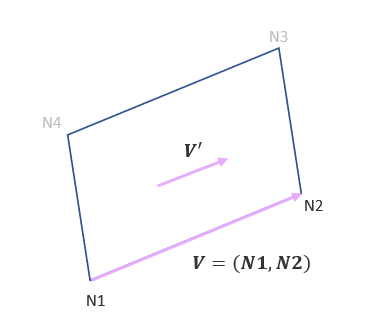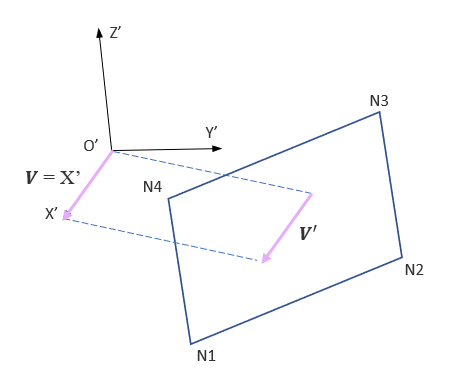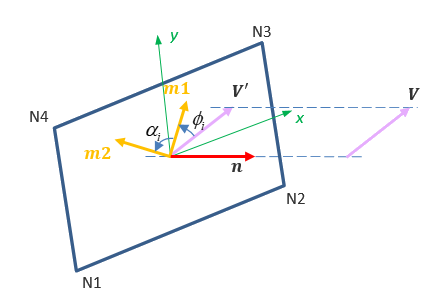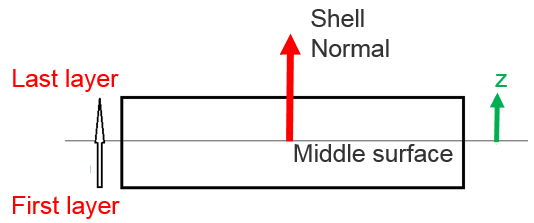/PROP/TYPE10 (SH_COMP)
Block Format Keyword This property set is used to define the composite shell property set. It is possible to define composite with several layers and each layer with individual orthotropic direction.
Format
| (1) | (2) | (3) | (4) | (5) | (6) | (7) | (8) | (9) | (10) |
|---|---|---|---|---|---|---|---|---|---|
| /PROP/TYPE10/prop_ID/unit_ID or /PROP/SH_COMP/prop_ID/unit_ID | |||||||||
| prop_title | |||||||||
| Ishell | Ismstr | Ish3n | Idrill | P_thickfail | |||||
| hm | hf | hr | dm | dn | |||||
| N | Thick | Ashear | Ithick | Iplas | |||||
| VX | VY | VZ | skew_ID | IP | |||||
| ... | |||||||||
Definition
| Field | Contents | SI Unit Example |
|---|---|---|
| prop_ID | Property
identifier. (Integer, maximum 10 digits) |
|
| unit_ID | Unit Identifier. (Integer, maximum 10 digits) |
|
| prop_title | Property
title. (Character, maximum 100 characters) |
|
| Ishell | Shell element formulation
flag. 1
(Integer) |
|
| Ismstr | Shell small strain
formulation flag. 2
(Integer) |
|
| Ish3n | 3 node shell element
formulation flag.
(Integer) |
|
| Idrill | Drilling degree of freedom
stiffness flag. 7
(Integer) |
|
| P_thickfail | Fraction of failed
thickness for shell element deletion. 10
(Real) Default = 1.0 (Real) |
|
| hm | Shell membrane hourglass
coefficient. Default = 0.01 (Real) Default = 0.1 for hourglass type 3 (Ishell =3) |
|
| hf | Shell out-of-plane
hourglass. Default = 0.01 (Real) |
|
| hr | Shell rotation hourglass
coefficient. Default = 0.01 (Real) Default = 0.1 for hourglass type 3 (Ishell =3) |
|
| dm | Shell Membrane Damping. Only active for Material Laws 25, 32 and 36. Default =1.5% for Ishell =24 (QEPH)+LAW25, 32 and 36 Default =5.0% for Ishell =1,2,3,4,12+LAW25 Default =0.0% for Ishell =1,2,3,4,12+LAW32 and 36 (Real) |
|
| dn | Shell numerical damping.
4 Only used for Ishell =12 and 24. Default =1.5% for Ishell =24 (QEPH) Default =0.1% for Ishell =12 (QBAT) Default =0.01% for Ishell =30 (DKT18) (Real) |
|
| N | Number of layers. Layer thickness is equal to Thick/N with 0 ≤ N ≤ 100. Default =1 (Integer) |
|
| Thick | Shell
thickness. (Real) |
|
| Ashear | Shear factor. Default is Reissner value: 5/6 (Real) |
|
| Ithick | Shell resultant stresses
calculation flag. 5
(Integer) |
|
| Iplas | Shell plane stress
plasticity flag. 6 It is available for Material Laws 2, 22, 32,
36 and 43.
(Integer) |
|
| VX | X component for reference
vector. 8 Default = 1.0 (Real) |
|
| VY | Y component for reference
vector. Default = 0.0 (Real) |
|
| VZ | Z component for reference
vector. Default = 0.0 (Real) |
|
| skew_ID | Skew identifier for
reference vector. 8 Default = 0 (Integer) |
|
| IP | Reference direction in
shell plane. 8
(Integer) |
|
| Angle for layer
1. (Real) |
||
| Angle for layer
2. (Real) |
||
| Angle for layer
3. (Real) |
||
| Angle for layer
4. (Real) |
||
| Angle for layer
5. (Real) |
||
| Angle for layer
N with 0 ≤ N ≤ 100 (5
angles per Line). (Real) |
Example

Figure 1. 6 Layers with Different Material Direction (Fiber Direction)
#RADIOSS STARTER
#---1----|----2----|----3----|----4----|----5----|----6----|----7----|----8----|----9----|---10----|
#- 1. LOCAL_UNIT_SYSTEM:
#---1----|----2----|----3----|----4----|----5----|----6----|----7----|----8----|----9----|---10----|
/UNIT/2
unit for prop
# MUNIT LUNIT TUNIT
kg mm ms
#---1----|----2----|----3----|----4----|----5----|----6----|----7----|----8----|----9----|---10----|
#- 2. GEOMETRICAL SETS:
#---1----|----2----|----3----|----4----|----5----|----6----|----7----|----8----|----9----|---10----|
/PROP/SH_COMP/2/2
SH_COMP example
# Ishell Ismstr Ish3n Idrill Pthick_fail
12 0 0 0 0
# hm hf hr dm dn
0 0 0 .1 .1
# N Thick Ashear Ithick Iplas
6 1.8 0 1 1
# Vx Vy Vz skew_ID Ip
1 0 1 0 0
# Phi_1 Phi_2 Phi_3 Phi_4 Phi_5
-60 -30 0 30 60
90
#---1----|----2----|----3----|----4----|----5----|----6----|----7----|----8----|----9----|---10----|
#enddata
#---1----|----2----|----3----|----4----|----5----|----6----|----7----|----8----|----9----|---10----|Comments
- Ishell, Ish3n – 4-node and 3-node
shell formulation flag
- Ishell =1,2,3,4 (Q4): original 4 node Radioss shell with hourglass perturbation stabilization.
- Ishell = 24 (QEPH): formulation with hourglass physical stabilization for general use.
- Ishell =12 (QBAT): modified BATOZ Q4γ24 shell with four Gauss integration points and reduced integration for in-plane shear. No hourglass control is needed for this shell.
- Ish3n =30 (DKT18): BATOZ DKT18 thin shell with three Hammer integration points.
- Flag Ishell =2 is incompatible with one integration point for shell element.
- Ismstr - Small strain
formulation
- Small strain formulation is activated from time t= 0, if Ismstr = 1 or 3. It may be used for a faster preliminary analysis, but the accuracy of the results is not ensured. Any shell for which can be switched to a small strain formulation by Radioss Engine option /DT/SHELL/CST, except if Ismstr = 4.
- If Ismstr = 1 or 3, the strains and stresses which are given in material laws are engineering strains and stresses; otherwise they are true strains and stresses.
- hm, hf, and hr - Hourglass coefficients
- hm, hf, and hr are only used for Q4 shells (Ishell =1,2,3,4). They must have a value between 0 and 0.05.
- For Ishell =3, default values of hm and hr are 0.1 with larger values possible.
- dn - Shell
numerical damping coefficient
- dn is only used for Ishell =12, 24 and Ish3n = 30:
- for Ishell =24 (QEPH) dn is used for hourglass stress calculation.
- for Ishell =12 (QBAT) dn is used for all stress terms, except transvers shear
- for Ish3n =30 (DKT18) dn is only used for membrane
- dn is only used for Ishell =12, 24 and Ish3n = 30:
- Ithick - Shell resultant
stresses calculation flag
- Flag Ithick is automatically set to 1 for /MAT/LAW32 (HILL).
- If Ithick =1, the small strain option is automatically deactivated in the corresponding type of element.
- Iplas - Shell plane stress
plasticity flag
- It is recommended to use Iplas = 1, if Ithick = 1.
- If Iplas=1, the small strain option is automatically deactivated in the corresponding type of element.
- Idrill
- Drilling DOF stiffness is recommended for implicit solutions especially for Riks method and bending dominated problems.
- Idrill is available for QEPH, QBAT (Idrill =12 and 24), and standard triangle (C0) shell elements (Ish3n = 1 and 2).
- Orthotropy direction
definition.The reference vector is projection of the input vector on the shell element surface and defined as following according to the flag IP:
- If IP=0 and skew_ID = 0, the vector is defined with VX , VY and VZ.
- If IP=0 and skew_ID ≠ 0, the vector is the first direction (local X) of the local coordinate system skew_ID.
- If IP = 20, the vector
is defined with the node N1 and N2
of the shell elements.

Figure 2. IP = 20 - If IP = 22, the vector
is the first direction (local X) of
the local coordinate system skew_ID. Vector
components VX, VY and
VZ are ignored.

Figure 3. IP = 22 - If IP = 23, the vector
is defined with
VX, VY and
VZ. The reference vector
is the product of vector
and shell element normal direction
Local coordinate system
skew_ID is ignored.

Figure 4. IP = 23
Then for each layer, the 1st material direction (m1) is vector turned degrees (turns positive direction around shell normal ).
Figure 5.The hierarchy order to define the reference vector is:- initial state card (/INISHE/ORTHO)
- shell property
In case of reference metrics, the orientation for directions of anisotropy must be defined with the reference geometry, not the initial one.
The 2nd material direction m2 is derived from direction m1 rotated 90 degrees (orthotropic).
Layers are overlaying one by one from bottom to top.
Figure 6. - The P_thickfail parameter is not compatible with failure defined within the material law itself, such as plastic failure strain in LAW36.
- Element deletion
rules used with P_thickfail and
failure models:
- Only P_thickfail
defined in the property is considered to trigger the element failure.
- P_thickfail > 0 defines a fraction of failed thickness. This uses the amount of element global thickness assigned to each layer.
- P_thickfail < 0 defines a ratio of failed layers. This uses the number of layers.
- The P_thickfail defined in failure model(s) (/FAIL) are not used.
- For fully-integrated shells (Ishell=12), the rules described above for under-integrated shells applies to each Gauss point separately. P_thickfail criterion is checked for all layers thickness for each in-plane Gauss point. The element is deleted only when all Gauss points reach P_thickfail criterion.
- P_thickfail rules are not used with failure models defined inside the material laws. It is used only for the failure model defined with /FAIL.
- Only P_thickfail
defined in the property is considered to trigger the element failure.